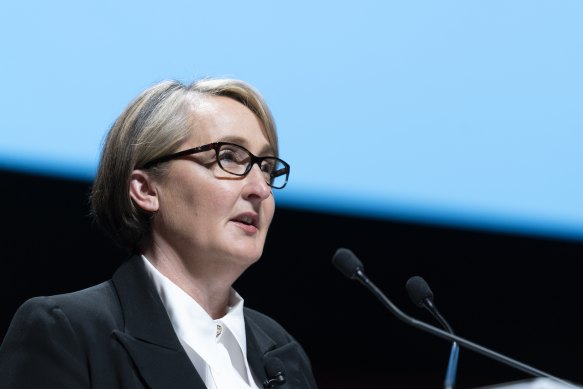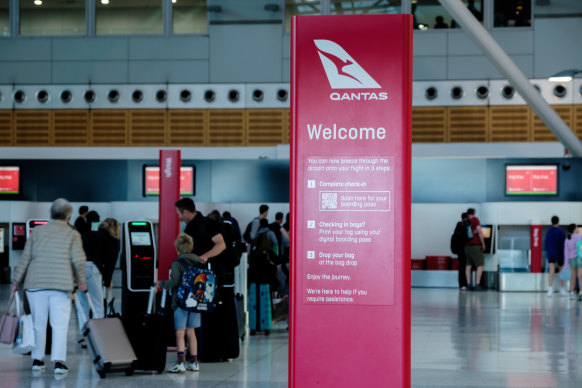This was published 1 year ago
Qantas lifts investment in planes, customer service as profits fall
By Amelia McGuire
Qantas boss Vanessa Hudson is banking on increased investment in new planes and customer service to deliver increased returns for shareholders, as airfares return to more normal levels, squeezing industry profits.
Unveiling a 13 per cent decline in first-half profits on Thursday, Hudson said the group’s capital expenditure bill will increase to between $3.5 billion and $3.7 billion by 2025, up from between $3 billion and $3.2 billion this year, and committed to an order of eight additional Airbus A321 XLRs.

“We understand the need for affordable air travel and fares have fallen more than 10 per cent since peaking in late 2022.” Qantas boss Vanessa Hudson. Credit: Eamon Gallagher
Profit after tax fell to $869 million in the six months to December 31, down from $1 billion in the prior-year period as margins tightened and airfares fell. Qantas’ share price sunk 6.8 per cent following the results to $5.21, as investors took in the lower-than-expected returns.
Hudson, presenting her first results as chief executive, said she stood by the controversial $1 billion restructure the airline committed to in the depths of the COVID-19 pandemic, even though the business is now pumping money into restoring customer service.
“At the time we made very deliberate decisions to not impact the customer product throughout that process.... But I think if I look at where we are now with where we’re obviously in an environment where we know a competitive market is changing around us, that’s why we need to invest more [in customer],” Hudson said.
She argued that the restructure was not intended to diminish customer service but lower costs in other ways, including by reducing head office headcount and by outsourcing ground handling – which was recently found by the High Court to have been illegal. It also modernised the IT systems, retired its fleet of Boeing 747s and offered a voluntary redundancy programme to cabin crew.
Qantas announced international earnings margins of more than 8 per cent for this financial year, underpinned by its plan to roll out direct flights between Europe and Australia’s east coast by 2025. The airline business flagged that this rollout has been pushed back by six months on Wednesday to accommodate for a delivery delay of the first A350.
Hudson told investors the group expected to spend $230 million on improving its customer and frequent flyer divisions annually. The airline business has been slammed by customers, staff and investors over the past two years for prioritising its bottom line over its product in recent years.
“We believe that the $230 million, including the investment that’s coming in Qantas frequent flyer, will be ongoing within that envelope across future years,” she said, but did not go into detail about the looming changes to its loyalty arm.
Hudson said she’s confident that demand will remain high amid increased cost of living pressures and lower returns from airline competitors including Air New Zealand and Singapore Airlines despite missing its international earnings margin target over the half.
“We’re seeing really strong demand across our networks. We’re seeing demand domestically in premium leisure but also in corporate travel,” she said, adding she was not concerned that the costs associated with the business’ recent High Court loss and looming Federal Court case lodged by the consumer watchdog would prevent further product investment.
Qantas is preparing to unveil wi-fi on international flights by the end of this financial year.
While no dividend was declared for the half, the carrier business announced another share buyback of up to $400 million on top of the $452 million it has bought back since August.
Underlying earnings before interest, tax, depreciation and amortisation – the metric most closely watched by investors– fell 13 per cent to $1.3 billion as the cost of airfares fell and the number of flights increased after the pandemic, putting pressure on its passenger and freight yields.
Qantas posted a record $2.47 billion in profit in the 2022-23 financial year, to the delight of investors and chagrin of customers who felt the airline group had prioritised its bottom line over passenger experience. Hudson said in August that record profit was not as good as it will get for Qantas.
Commenting on the result on Thursday, she struck a conciliatory tone, saying there was “a lot happening to lift our service levels, and the early signs are really positive”.
“We know that millions of Australians rely on us, and we’ve heard their feedback loud and clear,” she said in the results announcement. “We understand the need for affordable air travel and fares have fallen more than 10 per cent since peaking in late 2022.”

The airline announced a share buyback of up to $400 million.Credit: Oscar Colman
Hudson said the business is still on track to meet its domestic full-year earnings margin target from 13 per cent in 2019 to 18 per cent in 2024.
Lower fares contributed to reduced revenue per available seat kilometre – which is how airlines measure their yields – which had around a $600 million impact on profit, while freight yields fell by $146 million.
“However, this was mostly offset by contribution from increased flying of $485 million and unwinding of transition costs from the post-COVID-19 restart of $179 million,” the company said.
UBS analyst Andre Fromyhr said the result was “a touch disappointing” but he thought the outlook was within expectations.
“Management remain committed to performance targets but have no comment on the year’s progress against them,” Fromyhr said.
The Business Briefing newsletter delivers major stories, exclusive coverage and expert opinion. Sign up to get it every weekday morning.